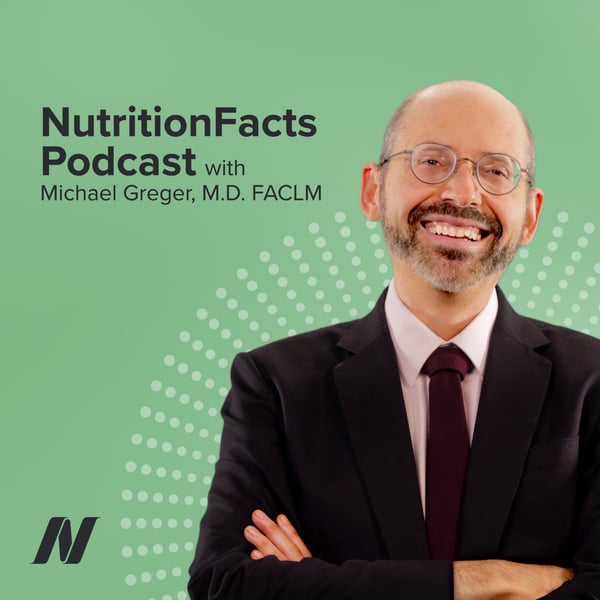Bad Breath
Nutrition Facts with Dr. Greger
[email protected]
4.8 • 3.6K Ratings
🗓️ 12 January 2023
⏱️ 12 minutes
🧾️ Download transcript
Summary
This episode features audio from How to Naturally Treat Tongue Coating-Associated Halitosis (Bad Breath) and Foods That Cause and Help Halitosis (Bad Breath). Visit the video pages for all sources and doctor's notes related to this podcast.
Transcript
Click on a timestamp to play from that location
| 0:00.0 | We have a lot of choices to make about our diet. Add to that doing the right thing when it comes to preventing or treating a chronic disease, |
| 0:08.0 | fighting a virus or losing weight, and suddenly our nutrition choices can seem almost overwhelming. |
| 0:15.0 | Well, I'm here to help. Welcome to the Nutrition Facts Podcast. I'm your host, Dr. Michael Greggert. |
| 0:22.0 | Today, we discuss the condition that we might not even know we have until someone is brave enough to tell us bad breath. |
| 0:32.0 | The word halatosis is derived from the Latin Greek terms for abnormal or diseased breath, so it may be less of a medical term and more of a marketing term, |
| 0:43.0 | as it was supposedly coined by the Listerine Company. |
| 0:47.0 | Halatosis, commonly referred to as bad breath, though medical and dental professionals often use instead of bad breath the less judgy term, breath odor. |
| 0:58.0 | As described in the Journal of Breath Research, halatosis has been classified into four types. |
| 1:04.0 | There's genuine halatosis, either transintercronic, which is contrasted with pseudo-halatosis, when someone thinks they have bad breath, but it's only only all in their head. |
| 1:14.0 | And halatophobia, where they start out with genuine halatosis, but then they treat it and get rid of it, but still think they have it. |
| 1:23.0 | These are rare, though. The vast majority of cases are IOH, which stands for intraoral halatosis, bad breath, arising from inside the mouth, as opposed to lungs or stomach, and not just anywhere in the mouth, but specifically, in most cases, apparently coming off the coating on the tongue. |
| 1:42.0 | Most people have a tongue coating, a grayish white deposit on the tongue, which is the main cause of bad breath. |
| 1:50.0 | And now there are pathological conditions like black, hairy tongue, whose symptoms may include an unattractive appearance of the tongue, which can be caused by certain drugs. |
| 2:02.0 | But the normal tongue coatings just a thin, slightly moist, whitish substance across the upper surface of the tongue, composed of sloughed tongue cells, bacteria, seepids from our blood supply and secretions for our gums and post nasal area, like mucus discharged from our sinuses dripping onto the back of our tongue. |
| 2:22.0 | Those with gum disease tend to have four times as much coating in terms of the wet weight scraped off the tongue due to the migration of white blood cells from periodontal pus pockets onto the tongue's surface, but even in people with perfect dental hygiene, food particles can get trapped between all the little bumps and craps on the tongue and form a thick bacterial biofilm coating. |
| 2:45.0 | If we eat the right foods though, our mouth may be self-cleaning. Just the act of chewing and swallowing foods that actually need chewing can cleanse off the tongue, leaving you with just a normal thin layer of coating. |
| 3:00.0 | But fast food is engineered to be eaten fast. It's soft, you can just gulp it down and consequently the thickness of the tongue coating might increase and that could contribute to bad breath, but you don't know until you put it to the test. |
| 3:17.0 | The effect of a chewing intensive high fiber diet on oral holotosis, a randomized clinical crossover study in which subjects were examined over a period of two and a half hours after consumption of a high fiber versus low fiber meal using an organoleptic assessment of holotosis. |
| 3:37.0 | Although a few electronic bad breath detectors have appeared on the market, organoleptic scoring is still the gold standard, which is just a fancy name for when dentists or doctors just give your breath a sniff. |
| 3:52.0 | Here's the ratings, they used. No holotosis detected, even up close and personal, or bad breath, but only up to about four inches away or out to a foot or all the way out to more than a yard. |
| 4:06.0 | We know holotosis is reduced by eating to the self-cleaning of the mouth while chewing food, and it seems obvious that foods that need to be chewed more intensively have a stronger self-cleaning effect than foods that require less chewing. |
| 4:20.0 | But whether this is actually the case, had never been examined until now. |
... |
Please login to see the full transcript.
Disclaimer: The podcast and artwork embedded on this page are from [email protected], and are the property of its owner and not affiliated with or endorsed by Tapesearch.
Generated transcripts are the property of [email protected] and are distributed freely under the Fair Use doctrine. Transcripts generated by Tapesearch are not guaranteed to be accurate.
Copyright © Tapesearch 2025.

